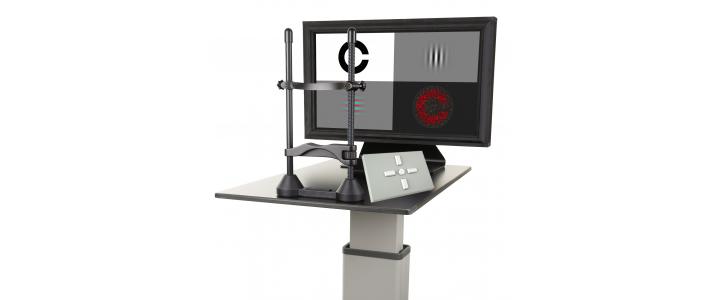Default Site / Tools for Vision Science / Metropsis Visual Function Assessment
Metropsis Visual Function Assessment

Precise tests of acuity, spatial and temporal contrast, colour and stereo vision
Metropsis is a complete test suite suitable for clinical, pre-clinical research, applied vision research, drug trials, screening, sports science and human factors research. The tests have been developed to investigate diseases of the eye and the brain, as well as changes in visual functions as a secondary effect of systemic disorders, such as cardiovascular diseases or neurological dysfunctions.
Guide Price: Enquire
SKU: M0400
Streamline your study with Metropsis
Metropsis is more sensitive than standard charts, easy to use, and our team will guide you to create test protocols and standard operating procedures to meet the specific requirements of your study.
Here's how we can help:
Initial Consultation
Our initial consultation will review the goals of your study; specifically including the disease type, the visual functions potentially involved, and the treatment.
We can then assist you in establishing which visual functions are primarily affected by the disease.
Test selection and customisation
We will help you to select appropriate tests of the required visual functions, taking particular account of the age group and visual abilities of your patients.
Metropsis includes a range of tests for visual acuity, spatial and temporal contrast sensitivity, colour discrimination, and binocular vision. They range from simple standardized acuity screening to specialised protocols for specific populations, such as colour tests for low vision patients.
These test protocols can be modified to meet your needs or, if necessary a new test can be developed for your study.
Definition of procedures
We will assist you in defining appropriate Standard Operating Procedures and Case Report Forms.
Setup and Training
We will then visit your site to set up the Metropsis Visual Function Assessment Unit and provide full training to get your study up and running.
Technical and scientific support
And of course, we will provide technical and scientific support throughout the course of your study.

Dr Caterina Ripamonti, Staff Vision Scientist
Katia joined Cambridge Research Systems from University College London, Institute of Ophthalmology, where she retains an Honorary Senior Research Fellowship. She is also an Honorary Research Fellow at Moorfields Eye Hospital.
Katia is the author of various papers on human colour vision, spatial and temporal properties of normal and defective vision, and applied aspects of colour science related to human factors, as well as the co-author of the book Computational Colour Science using MATLAB.
Publications: https://www.researchgate.net/profile/Caterina_Ripamonti
Katia's presentations at ARVO 2016
Program Number: 2290 Presentation Time: 4.30pm-4.50pm Room 611/612 Caterina Ripamonti “The development of colour discrimination” Early visual experience - Mini-symposium
Program Number: 191 - B0090 Presentation Time: 8.30am-10.15am Room 611/612 Caterina Ripamonti, Jakob S. Thomassen “Necessary colour correction for the implementation of the Cambridge Colour Test on a LCD monitor” Visual function in normal and aging vision Poster Range: B0089 - B0114
![]() Necessary colour correction for the implementation of the Cambridge Colour Test on a LCD monitor
Necessary colour correction for the implementation of the Cambridge Colour Test on a LCD monitor
Metropsis includes ALL of these protocols:
It's a complete toolkit from fast and easy screening to in-depth investigation of subtle changes in visual function. The protocols listed below can be modified to your requirements or, if necessary, a new test can be developed.
Visual Acuity

The ETDRS charts test is used for a quick and easy screening of visual acuity.
The Landolt C test and Optotypes test are more sensitive tests that reveal smaller change in visual acuity due to disease progression or treatment.
Crowding bars are recommended when testing subject with amblyopia.
Spatial Contrast Sensitivity

Spatial contrast sensitivity measurements provide valuable information about visual losses caused by retinal dysfunctions in the peripheral field, or due to more general ophthalmological or neurological disorders.
The ETDRS Contrast Sensitivity Chart provides quick results in a format that is very familiar to both patients and examiners.
The Achromatic Contrast Sensitivity Function (CSF) provides precise measurements relative to the CSF peak and cut-off frequency
Temporal Contrast Sensitivity

Temporal contrast sensitivity function (often known as the "Flicker Test") indicates the light and dark adaptation ability, and may be able to differentiate age related changes from those with clinical causes.
Colour Discrimination

Depth Discrimination

*The Depth Discrimination test uses a random dot stereogram stimulus and therefore requires the stereo capable version of the Display++, which is NOT included in the standard package. However, if you choose to purchase the Display++ Stereo, you will also get free access to this test.
Metropsis is more sensitive than other eye tests
Printed eye charts are unsuitable
Although eye charts such as the ETDRS can provide a quick assessment of spatial resolution, it is limited to one level of contrast, to a high spatial frequency content, and only tests the central visual field. For this reason, such tests often miss significant losses in contrast sensitivity caused by retinal dysfunctions occurring in the peripheral visual field, or due to more general ophthalmological or neurological disorders.
Ordinary computer LCDs are inaccurate
They have inadequate colour resolution and their light output is non-uniform across the screen and unstable over time.
ARVO 2016 Program Number: 191 - B0090 Presentation Time: 8.30am-10.15am Room 611/612 Caterina Ripamonti, Jakob S. Thomassen “Necessary colour correction for the implementation of the Cambridge Colour Test on a LCD monitor” Visual function in normal and aging vision Poster Range: B0089 - B0114
Metropsis technology is designed for science
Metropsis generates and displays visual stimuli using Display++, our 32" calibrated LCD monitor, which is designed from the ground up for scientific applications. Display++ has custom LED backlight and a FHD 1920x1080 IPS LCD panel which supports 120Hz panel drive and up to 16-bit colour resolution.
The intensity of the backlight can be adjusted manually and the required peak light output set in calibrated photometric units across a wide range: mesopic and photopic levels are directly supported, and scotopic levels can be achieved with an ND filter. The monitor is calibrated, characterised and gamma-corrected at the factory and has an integrated real time calibration sensor system, which means that there is no need to perform any additional measurements. The monitor is remains calibrated over time and is ready for use immediately from switch-on.
These unique Display++ properties allow you to display visual stimuli with a high spatial and colour resolution, and change their properties on a fine scale.
Ultimately, this means that you will be able to measure more precise and consistent visual thresholds and accurately monitor their changes over time.
All key hardware is included:

- Display++ 32" display for stimulus presentation.
- Response box, for the observer to communicate their responses (used in some tests).
- A 21.5" iMac with the Metropsis software pre-installed, and factory configured to drive Display++
- iPad for experimenter to control the test and record responses (used in some tests).
You may also like to add some of these options:
- Direct interaction with the stimulus: Display++ Touchscreen*
- Stereo capability - required for stereo acuity test: Display++ Stereo*
- Head stabilisation: Eyelock chinrest
- Fixation monitoring: Livetrack FM
- Motorized height adjustable table: Hercules table
*Please note that the Stereo and Touchscreen capabilites are not part of the standard package and cannot be retro-fitted to a standard Display++ after purchase. Therefore if you plan to use these features in the future, you should specifiy them in your original purchase.


